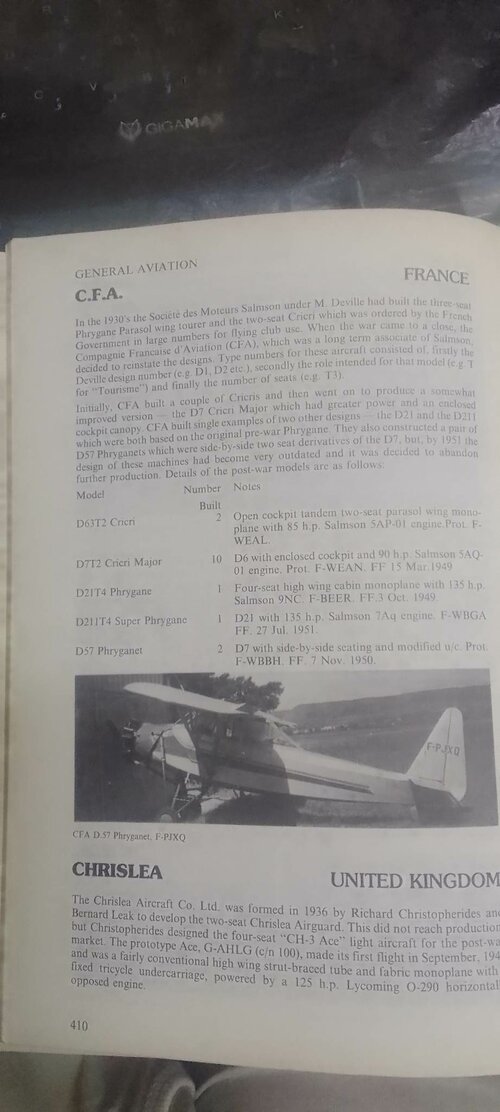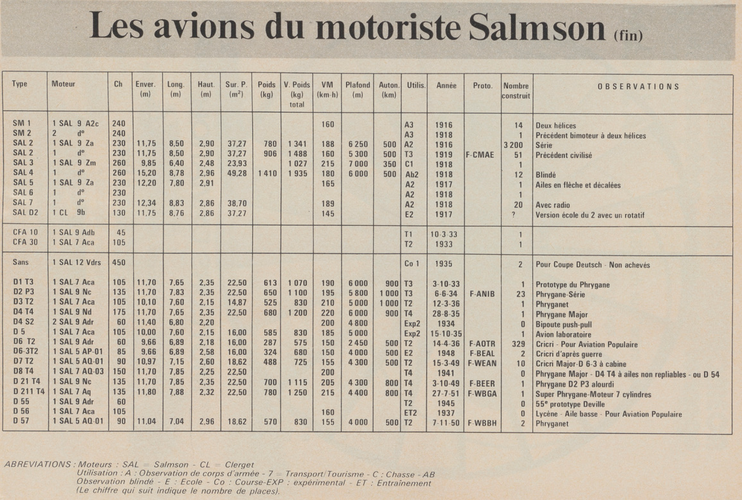- Joined
- 25 July 2007
- Messages
- 4,299
- Reaction score
- 4,193
Aircraft Designations of the Société des Moteurs Salmson [1]
There are four main designation systems relating to the Société des Moteurs Salmson (SMS). However, a lone example of an earlier, internal SMS factory designation is know. This A92H designation dates to 1915 and likely suggests concept studies still on the drawing board. What is known is that this A92H concept becomes the series-produced S.M.1.
This 1915 factory designation is partly of interest because it reveals that the SMS engine designation system was also in flux at the time. The factory designation A92H was meant to stand for engine type + number of propellers used. So, a design powered by a Salmson 'A9' (sic) - ie: the Salmson 9A2c water-cooled radial engine - plus deux Hélices. As noted above, A92H may simply have been a design department concept description for drawings.
The first SMS designation sequence for built aircraft was the short 'S.M.' (Salmson-Moineau) series covering the designs of ingénieur René Moineau between 1916 and May 1918. Oddly, by 1917, this 'S.M.' series had already been eclipsed by a form of Aviation Militaire (AM) designations. Despite this, the 1918 S.M.2 prototype retained the original form. As will be seen, the AM designations bore no real relationship to the truncated 'S.M.' series.
For now, I present the two known 'S.M.' designation types. [2] The S.M.1 and S.M.2 were directly related - the latter prototype being a twin-engined evolution of the former. Both shared peculiar forms of engine arrangement.
_______________________________________________
Salmson-Moineau 'S.M.' Aircraft Designations
Covering René Moineau's aircraft designs for Société des Moteurs Salmson (1916-1918). [3]
S.M.1 - 1916 3-seat long-range recce biplane; x ~155
- S.M.1 : Shaft-driven propellers; one on either side
- S.M.1 : 1 x 240 hp Salmson 9A2c 9-cyl.;* span 17.47 m
-- * Water-cooled; transversely-mounted in fuselage
- S.M.1 : 1915 designed by ex-Breguet René Moineau
- A92H : Factory desig.; for Salmson A9 + 2 Hélices
- S.M.1 A.3: STAé designation; 100 x Nov 1916 order
- Sal.1 A.3 : May 1918 AM aircraft designation change
S.M.2 - 1918 2-engined, 3-prop attack biplane; x 1
- S.M.2 : Prototype derived from an S.M.1 airframe
- S.M.2 : 2 x 240 hp Salmson 9A2c;* span 20.00 m
- S.M.2 : 1 x transverse Salmson 9A + 1 x forward
-- * Transverse shaft-drove 2 x props, fwd 1 tractor
-- Warren truss bracing of longer-span upper wings
- S.M.2 S.2: STAé designation; reinforced structure
_______________________________________________
[1] Doubtless designations (or unbuilt projects) will be missing from these lists. Does anyone have access to a copy of Maurice Victor's 2007 book Paul Deville et ses Cinquante Huit Prototypes? I'm guessing that there may be hidden gems contained within.
[2] Since the next SMS designation series originated with the Aviation Militaire, it is perhaps possible that further 'S.M.' series designation numbers were applied internally at Salmson's Boulogne-Billancourt factory. However, I have found no evidence of such later 'S.M.' numbers.
[3] Postwar, ingénieur Moineau became more interested in research questions than actual aircraft design. After gaining a number of patents, he eventually settled on rotary-wing research. In 1924, he formed the société Avions René Moineau.
There are four main designation systems relating to the Société des Moteurs Salmson (SMS). However, a lone example of an earlier, internal SMS factory designation is know. This A92H designation dates to 1915 and likely suggests concept studies still on the drawing board. What is known is that this A92H concept becomes the series-produced S.M.1.
This 1915 factory designation is partly of interest because it reveals that the SMS engine designation system was also in flux at the time. The factory designation A92H was meant to stand for engine type + number of propellers used. So, a design powered by a Salmson 'A9' (sic) - ie: the Salmson 9A2c water-cooled radial engine - plus deux Hélices. As noted above, A92H may simply have been a design department concept description for drawings.
The first SMS designation sequence for built aircraft was the short 'S.M.' (Salmson-Moineau) series covering the designs of ingénieur René Moineau between 1916 and May 1918. Oddly, by 1917, this 'S.M.' series had already been eclipsed by a form of Aviation Militaire (AM) designations. Despite this, the 1918 S.M.2 prototype retained the original form. As will be seen, the AM designations bore no real relationship to the truncated 'S.M.' series.
For now, I present the two known 'S.M.' designation types. [2] The S.M.1 and S.M.2 were directly related - the latter prototype being a twin-engined evolution of the former. Both shared peculiar forms of engine arrangement.
_______________________________________________
Salmson-Moineau 'S.M.' Aircraft Designations
Covering René Moineau's aircraft designs for Société des Moteurs Salmson (1916-1918). [3]
S.M.1 - 1916 3-seat long-range recce biplane; x ~155
- S.M.1 : Shaft-driven propellers; one on either side
- S.M.1 : 1 x 240 hp Salmson 9A2c 9-cyl.;* span 17.47 m
-- * Water-cooled; transversely-mounted in fuselage
- S.M.1 : 1915 designed by ex-Breguet René Moineau
- A92H : Factory desig.; for Salmson A9 + 2 Hélices
- S.M.1 A.3: STAé designation; 100 x Nov 1916 order
- Sal.1 A.3 : May 1918 AM aircraft designation change
S.M.2 - 1918 2-engined, 3-prop attack biplane; x 1
- S.M.2 : Prototype derived from an S.M.1 airframe
- S.M.2 : 2 x 240 hp Salmson 9A2c;* span 20.00 m
- S.M.2 : 1 x transverse Salmson 9A + 1 x forward
-- * Transverse shaft-drove 2 x props, fwd 1 tractor
-- Warren truss bracing of longer-span upper wings
- S.M.2 S.2: STAé designation; reinforced structure
_______________________________________________
[1] Doubtless designations (or unbuilt projects) will be missing from these lists. Does anyone have access to a copy of Maurice Victor's 2007 book Paul Deville et ses Cinquante Huit Prototypes? I'm guessing that there may be hidden gems contained within.
[2] Since the next SMS designation series originated with the Aviation Militaire, it is perhaps possible that further 'S.M.' series designation numbers were applied internally at Salmson's Boulogne-Billancourt factory. However, I have found no evidence of such later 'S.M.' numbers.
[3] Postwar, ingénieur Moineau became more interested in research questions than actual aircraft design. After gaining a number of patents, he eventually settled on rotary-wing research. In 1924, he formed the société Avions René Moineau.


